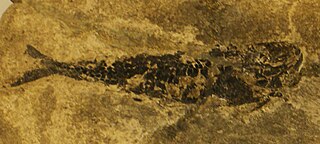Aphnelepis is an extinct genus of prehistoric freshwater ray-finned fish that lived during the Late Jurassic epoch. It contains a single species, A. australis, from the Talbragar River beds of New South Wales, Australia.

Atopocephala is an extinct genus of prehistoric freshwater ray-finned fish that lived during the Middle Triassic epoch. It contains a single species, A. watsoni from the Karoo Supergroup of South Africa. A potential indeterminate species was known from the Timezgadiouine Formation of Morocco, but is now considered an indeterminate actinopterygian.
Tripelta is an extinct genus of prehistoric bony fish that lived during the Anisian age in what is now New South Wales, Australia.
Daedalichthys is an extinct genus of prehistoric freshwater ray-finned fish that lived during the Early Triassic epoch. It contains a single species, D. formosa from the Olenekian-aged Cynognathus Assemblage Zone of South Africa. It was previously classified in Dictyopyge.
Helichthys is an extinct genus of prehistoric bony fish that lived during the Early Triassic epoch in what is now South Africa.
Sakamenichthys is an extinct genus of prehistoric bony fish that lived during the Early Triassic epoch in what is now Madagascar. Fossils were recovered from beds of the Middle Sakamena Formation of the Beroroha basin in the southern part of the island.

Pteronisculus is an extinct genus of prehistoric ray-finned fish that lived during the Early Triassic and Middle Triassic epochs of the Triassic period worldwide.
Agecephalichthys is an extinct genus of prehistoric freshwater "palaeonisciform" ray-finned fish that lived during the Anisian age. It contains a single species, A. granulatus from the Hawkesbury Sandstone in what is now New South Wales, Australia.
Caruichthys is an extinct genus of prehistoric freshwater ray-finned fish that lived during the Early Triassic epoch. It contains a single species, Caruichthys ornatus, known from what is now South Africa. It is known from a single specimen, which was collected from the middle Beaufort Series of Doorn River.

Garnbergia is an extinct genus of prehistoric coelacanth that lived during the Anisian stage of the Middle Triassic epoch. It was discovered by Martin and Wenz in 1984. It comprises a single species, Garnbergia ommata.
Chrotichthys is an extinct genus of prehistoric freshwater ray-finned fish that lived in the Anisian stage of the Middle Triassic epoch. It contains a single species, C. gregarius, known from the Terrigal Formation of New South Wales, Australia.
Luganoia is an extinct genus of prehistoric bony fish that lived during the Anisian and Ladinian ages of the Middle Triassic epoch. Fossils were recovered from the Besano Formation of Monte San Giorgio and Besano area and from the Zhuganpo Member of Guizhou, South China. It was also reported from the Ladinian of Spain.

Besania is an extinct genus of prehistoric marine ray-finned fish that lived during the Anisian and Ladinian ages of the Middle Triassic epoch in what is now southern/southeastern Switzerland and northern Italy. Fossils were recovered from the Besano Formation of Monte San Giorgio area and the Prosanto Formation of canton Graubünden, Switzerland.

Aetheodontus is an extinct genus of prehistoric marine bony fish that lived during the early Ladinian stage of the Middle Triassic epoch of what is now Italy and Switzerland. It contains a single species, A. besanensis.

Acentrophorus is an extinct genus of prehistoric freshwater and marine ray-finned fish from the Roadian to the Wuchiapingian of England, Germany (Kupferschiefer), Italy and Russia. There may also be a Triassic occurrence in Australia.
Corunegenys is an extinct genus of prehistoric freshwater ray-finned fish that lived during the Late Triassic epoch near what is now Bowral in New South Wales, Australia. It contains a single species, C. bowralensis. Some studies suggest that it may be related to Semionotus capensis.

Meridensia is an extinct genus of prehistoric ray-finned fish that lived during the Anisian and Ladinian ages of the Middle Triassic epoch in what is now southern Switzerland and northern Italy. Fossils were recovered from the Besano Formation of Monte San Giorgio and Besano area at the Swiss-Italian boundary.

Placopleurus is an extinct genus of prehistoric ray-finned fish from the Middle Triassic epoch of Italy, Slovenia, and Switzerland.

Redfieldiiformes is an extinct order of ray-finned fish (actinopterygians) which lived from the Early Triassic to Early Jurassic. Redfieldiiforms were fairly typical Triassic fish in overall anatomy. They had a fusiform body shape with thick, ganoine-covered scales. The dorsal and anal fins were large, positioned opposite from each other, and shifted back, close to the tail. The caudal fin was hemiheterocercal, with the vertebral column and body scales extending into an upper lobe equal in size and shape to the lower lobe. They also had several characteristic skeletal traits, such as a hatchet-shaped preopercle, a series of fulcra fringing the fins, a reduced number of branchiostegal rays, and a snout ornamented with tubercles.
Brazilichthys is an extinct genus of prehistoric freshwater ray-finned fish that lived during the Cisuralian epoch in what is now Maranhão, Brazil. The type and only species, B. macrognathus, is known from a single partially complete skull, which was recovered from the Pedra de Fogo Formation near Pastos Bons, Maranhão, Brazil.













